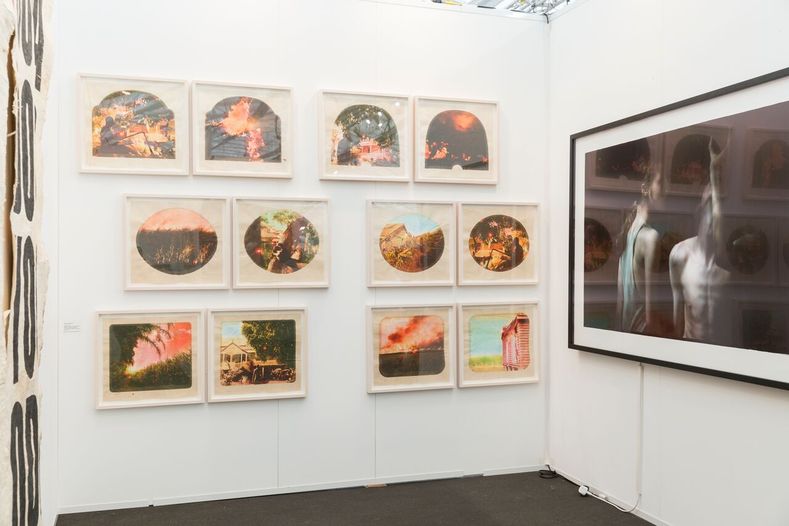
R
E
V N
E
X
T
TONY GARIFALAKIS, “Bloodline” series, 2014–16, enamel on C-type prints. Installation view at Sarah Scout Presents’ booth at Auckland Art Fair. Courtesy Auckland Art Fair.
Prior to my moving from New Zealand to Canada in 2005, a trip to Europe usually meant packing as much in as possible, and in this sense the Art Basel art fair offered a special opportunity as a one-stop-shop to meet gallerists, artists, colleagues and collectors. In those early days there were two groups; the preview day art community and the fair goers, though the distinction tended to evaporate after the first day. The Kunsthalle bar was the late-night hub for hanging out and comparing notes, and it was there in 2001 that then-Frieze editor Matthew Slotover commented to me that London needed a fair like Basel. A year later Art Basel in Miami Beach launched, followed by London’s Frieze fair in 2003. Those launches proved to be a watershed moment in the rapid transformation of the international art fair, from being an important component of the art ecology to being a central element of the global art economy. As a result, smaller and lesser-capitalized fairs have struggled. While some have slipstreamed on the pull of the larger fairs by co-locating with them, it is the regional fair that has been hardest hit, with certain fairs folding altogether in response to dwindling attendance by international collectors and the consequent non-return of major galleries. It seems regional art fairs might need to redefine their niche in order to survive.
If the big global fairs feel as familiar as ever, they are also increasingly alienating to many of us, because they have lost a core sense of intimacy and shared community. Generally they reflect the globalization of the market (Ai Weiwei is now perennially presented), but most often regional contexts are eschewed in favor of a grand mash-up of periods and styles. There is an opportunity, then, for the regional fair to focus on the validity of regional specificity and to make a virtue of slowing down and taking a deeper and more intimate dive.
Under new ownership, the Auckland Art Fair in New Zealand took this remit on board in a major reboot for its 2016 edition, presenting 40 galleries from the South Pacific. Most were from New Zealand itself, a country not short on outstanding artists and discerning galleries. In addition, a feature of this year’s fair was the unprecedented number of Australian galleries represented, including the return of Roslyn Oxley9 Gallery, a seasoned attendee of many major international fairs. The enterprising Bergman Gallery from the Cook Islands and the self-described nomadic gallery Mutt, from Chile, rounded out the mix.
EVE ARMSTRONG, Trading Table, 2003– , an interactive installation in which the artist set up a table at the booth of Michael Lett gallery, where she facilitated the exchange of objects, skills, ideas and information with visitors. Courtesy Auckland Art Fair.
A number of galleries included a mix of local and international artists in their stables, although for the most part the focus was on artists from the local region. This focus was also reflected in the Talks Programme and the Projects Programme, titled “Pacific Real Time,” curated by Simon Rees, Jarrod Rawlins and Francis McWhannell. The programs raised questions concerning the significance of location and region for artistic practice in the face of globalization and instant connectedness. Los Angeles-based New Zealand artist Fiona Connor nailed the issue with Community Notice Board (Silverdale) (2015), a facsimile of a rural noticeboard. While some locally based Asian artists were presented, visibly absent were Asian galleries, which was especially notable given Auckland’s significant Asian population and the history of its artists exhibiting in New Zealand. Future editions could consider extending the regional reach by commissioning projects from Asia and the American west coast.
Nonetheless, the overall quality of the presentations was high, with many booths standing out for the singularity and thoughtfulness of their display, including Anna Miles Gallery Hopkinson Mossman, Sarah Scout Presents and Michael Lett gallery. The latter’s solo presentation of Eve Armstrong’s Trading Table (2003– ) was a clever engagement with the idea of the art fair, which turned the tables on the commercial factor of the event and allowed everyone to participate. While less singular, many other booths stood out for their considered presentation of a wide range of works, including Roslyn Oxley9, The Commercial, Starkwhite and Peter McLeavey Gallery.
The 2016 edition of Auckland Art Fair demonstrated a commitment to professionalism in an airy, well laid out and light-filled venue known as the Cloud, located on the edge of downtown Auckland’s scenic harbor. The presentations, which allowed visitors to sample some of the strongest works currently being produced in the region, were also cognizant of the larger international context in which most of the artists operate. Overall the fair offered a mix of intimacy, approachability and confidence, which bodes well for the future of the event as a leading fair for the region.
Auckland Art Fair took place at the Cloud on Auckland’s Waterfront from May 25–29, 2016.





